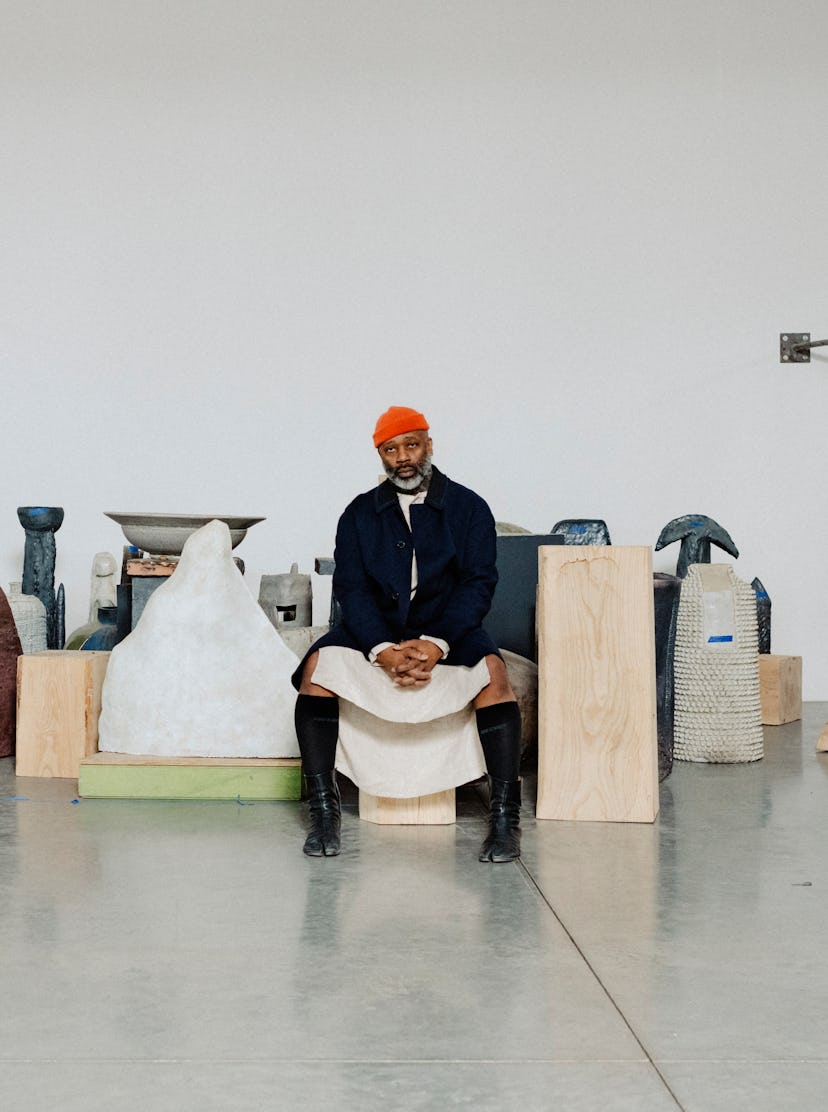With a New Show, Theaster Gates Brings Freedmen’s Town Out of Obscurity
The Chicago artist examines the dynamics behind the historic Houston municipality built in 1865 by newly freed Black people.

Theaster Gates’s latest exhibition came about at the very moment the artist decided to overhaul his approach to mounting shows. The Chicago native—whose installations and sculptures have been shown worldwide over the course of his nearly two-decade career—was interested in tackling longer-term projects, dialing back the pace, and taking on a challenge that would dictate the future of a place or a people. For “Theaster Gates: The Gift and the Renege,” that place was Houston’s historic Fourth Ward—specifically, Freedmen’s Town, built in 1865 by newly freed Black people who formed and fostered a self-sufficient and vibrant community.
Gates—winner of the 2018 Nasher Prize, the 2023 Isamu Noguchi award, and a whole laundry list of other accolades—has centered his practice on revitalizing underserved areas by fusing urban planning and art for years. Reimagining the future of a place or a people also happens to be the basis of the Contemporary Arts Museum Houston’s latest project, “Rebirth in Action: Telling the Story of Freedom,” of which “The Gift and the Renege” is a part. Gates’s show, launched in partnership with the Freedmen’s Town Conservancy, aims to honor and preserve the heritage of this unique Texas location while highlighting both the seen and the unseen dynamics of Freedmen’s Town. Along with “The Gift and the Renege,” “Rebirth in Action” will also host community stakeholder meetings, walking tours, and “THIS WAY: A Houston Group Show,” showcasing work from a dozen local Black artists interpreting the legacy of the Freedmen Town community.
On view at CAMH through October 20, “Theaster Gates: The Gift and the Renege” features new and recent installations, paintings, and sculptures—“a series of poetic gestures,” as Gates describes them during a recent interview from the museum’s office. Those “gestures” include Retaining Wall for Revolution and Resurrection, (a steel case containing supplies from mom-and-pop stores of yesteryear, which Gates says “held the world together,”) and New Egypt Sanctuary of the Holy Word and Image, (a towering wooden “sanctuary” of leather-bound Ebony magazines, what the artist calls a “metaphor of Black precarity,” contributing to his practice of “accumulating people’s problems”). All of the pieces on view reckon with the histories of labor, material legacies, and the sociopolitical architecture of this historic, resident-made environment.
Installation view of “Theaster Gates: The Gift and the Renege” at Contemporary Arts Museum Houston. Background: Bright Sunny Day, 2024; foreground: WE WILL SAVE OURSELVES, 2024.
Installation view of “Theaster Gates: The Gift and the Renege” at Contemporary Arts Museum Houston. Retaining Wall for Revolutionand Resurrection, 2024.
Gates was approached by Hesse McGraw, executive director of CAMH and cocurator of the show, during the height of the Covid-19 pandemic about “The Gift and the Renege.” The idea “amplified the great work that was happening at Freedmen’s Town around the preservation and conservation of their bricks,” Gates says, “along with a broader initiative of bringing this place out of obscurity and helping the rest of the literate world know that it exists—[because] y’all need to know about it.” Working on the Freedmen’s Town project ended up gelling with the artist’s desire for a slower practice—one with an impact that could be felt, heard, and seen beyond the confines of a museum’s white walls. “We were able to imagine the role that artists could play by helping tell the story of Freedmen’s Town,” McGraw adds. “[It ended up] reinforcing a longer-term strategy, which is preservation, rebirth, reactivation, and building up this broader narrative about this very special neighborhood.”
The actual foundation of Freedmen’s Town— which stands today with new and old housing, churches and monuments, The African American Library at the Gregory School, and stunning murals that tell stories of Black history—was its brick streets, laid by the hands of residents who created an entire infrastructure without the influence and infiltration of outside forces (a counter to the idea that newly freed slaves could not sustain themselves beyond the confines of slavery). Over the years, the former bustling community has been affected by gentrification and government sanctioned domain laws, which extracted land from the Black community and forced their displacement to make way for new developments. Around 40,000 Black residents in the late 1950s, for instance, were removed from their homes to accommodate the construction of a new highway.
Gates says that, when it comes to Freedmen’s Town, these art activations and exhibitions can shed light on the need for conservancy on a broader scale. The eradication of Black spaces and places, he says, is not a singular phenomenon.
“What happens if I bring my knowledge home and Freedmen’s Town feels like a place where we not only rethink its history, but it becomes a repository of Black intelligences?” the artist says. “These are nation builders. And they built this big nation—and they built a nation for themselves.” (This concept of “nation building” and the arduous work it entailed is represented in the exhibition through a series of brick presses that Gates thrice replicated from an original cast-iron model used to lay down the land.)
Installation view of “Theaster Gates: The Gift and the Renege” at Contemporary Arts Museum Houston. Background: Stainless Labor, 2024. Foreground: Brick Relief, 2024.
Installation view of “Theaster Gates: The Gift and the Renege” at Contemporary Arts Museum Houston. WE WILL SAVE OURSELVES, 2024.
“For a people who haven’t always seen ourselves as master of our fate, that external world is constantly impeding on us—no,” Gates says. “If they destroyed Old Egypt, we will build New Egypt. We got the tools, we got the libraries, we got the sermon.” The artist punctuates his message by reiterating a credo that he burned onto a large piece of steel for an artwork featured prominently, starkly in “Theaster Gates: The Gift and the Renege”: “We will save ourselves!”